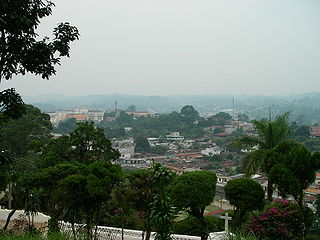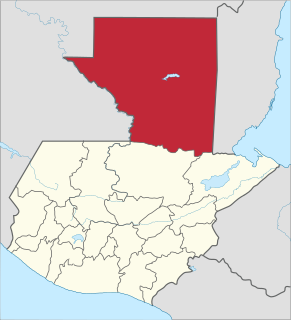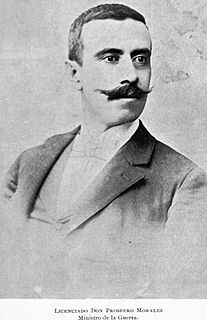
Alta Verapaz is a department in the north central part of Guatemala. The capital and chief city of the department is Cobán. Verapaz is bordered to the north by El Petén, to the east by Izabal, to the south by Zacapa, El Progreso, and Baja Verapaz, and to the west by El Quiché.

Cobán, fully Santo Domingo de Cobán, is the capital of the department of Alta Verapaz in central Guatemala. It also serves as the administrative center for the surrounding Cobán municipality. It is located 219 km from Guatemala City.

Petén is a department of Guatemala. It is geographically the northernmost department of Guatemala, as well as the largest by area — at 35,854 km2 (13,843 sq mi) it accounts for about one third of Guatemala's area. The capital is Flores. The population at the mid-2018 official estimate was 595,548.
Livingston is a town, with a population of 17,923, in Izabal Department, eastern Guatemala, at the mouth of the Río Dulce at the Gulf of Honduras. The town serves as the municipal seat of the municipality of the same name. It was Guatemala's main port on the Caribbean Sea before the construction of nearby Puerto Barrios.
Chisec is a town and municipality in the north of the Guatemalan department of Alta Verapaz that was founded in 1813. It is situated at 230 metres (755 ft) above sea level. The municipality covers a territory of 1244 km². Approximately 95% of the municipality's inhabitants are Mayan, spread over the town of Chisec and approximately 140 communities. The Q'eqchi' language is widely spoken there alongside Spanish.
Fray Bartolomé de las Casas is a municipality in the Guatemalan department of Alta Verapaz. It is situated at 170m above sea level. It contains 31,611 people. It covers a terrain of 1229km2. The annual festival is April 30-May 4. It is named after the 15th-century Spanish priest, bishop, and writer Bartolomé de Las Casas.

San Cristóbal Verapaz is a town, with a population of 20,961, and a municipality in the Guatemalan department of Alta Verapaz. It is located approximately 29 km from Cobán, the capital of Alta Verapaz and about 210 km from Guatemala City. San Cristóbal belongs to the Pokimchi' linguistic area. Its main income source is the «Cobán» shoe factory, which specializes in industrial rubber boots, which are sold both locally and internationally.

Morales is a municipality in Izabal Department of Guatemala. The municipality was created in 1920 and is formed by the town of Morales, 9 villages and 56 rural communities. The Cuevas del Silvino National Park is located a few kilometers northeast of Morales.
El Estor is a town, with a population of 20,489, and a municipality in the Izabal department of Guatemala. The population of El Estor consists largely of Q’eqchi’ speaking indigenous people.

The Maya Biosphere Reserve is a nature reserve in Guatemala managed by Guatemala's National Council of Protected Areas (CONAP). The Maya Biosphere Reserve covers an area of 21,602 km², one-fifth of the country's total land area.
Biosphere reserves in Guatemala include:

Lachuá Lake is a karstic lake in Guatemala. It is located in the middle of a national park covered with tropical rain forest, northwest of Cobán, near the border between the departments of Alta Verapaz and El Quiché. The lake is near circular in shape and is probably a cenote or doline. The lake water has a slightly sulphurous smell, which may explain the origin of its name: "Lachuá" is derived from the Q'eqchi' words "la chu há" which means "the fetid water". The water contains a relatively high degree of calcite and tree branches fallen into the lake are quickly covered with a white calcite layer.
Chahal is a municipality in the Guatemalan department of Alta Verapaz. The name originates from the Mayans.
Cuatro Balam is an initiative by the government of Guatemala to dramatically increase tourism in the Maya Biosphere Reserve, focusing on the region's numerous archeological sites. The Reserve is a protected area of 21,602 km² in Guatemala's northernmost Petén Department. The Reserve contains national parks and wildlife preserves, and "multiple use" zones where limited human settlement and activity are permitted.
El Rosario National Park is located in El Petén, Guatemala, on the eastern edge of the town of Sayaxché.. The park is named after laguna El Rosario, a small lake within its boundaries, and was formerly a state owned finca managed by the National Forestry Institute (INAB). In 1980 it was declared a national park. The park covers an area of 11.05 km2, including the El Rosario lake, which has a surface area of 4 ha in the dry season, though it is considerably larger during the rainy season.
The Centro de Estudios Conservacionistas is a scientific research institute of the San Carlos University of Guatemala (USAC). The center was created in August 1981, and since February 1982 has been administratively attached to USAC's faculty of chemistry and pharmacy.
Guatemala is divided in 22 departments that are organized in 8 development regions declared by the Guatemalan government.

The Franja Transversal del Norte is a region in Guatemala delimited to the north by an imaginary line between Vértice de Santiago in Huehuetenango and Modesto Méndez Port in Izabal and in the south by La Mesilla in Huehuetenango and Izabal lake. It is composed, from west to east, of part of the Guatemalan departments of Huehuetenango, Quiché, Alta Verapaz and the entire department of Izabal. It extends roughly 15750 km2. During the Guatemalan Civil War, most of the massacres took place there due to the oil, mineral and precious wood reserves in the region. In the 21st century, there are projects to work in the region and a modern highway was built in 2010.
Tourism became one of the main drivers of Guatemala's economy, an industry that reported more than $1.8 billion in 2008. Guatemala receives about two million tourists annually.








